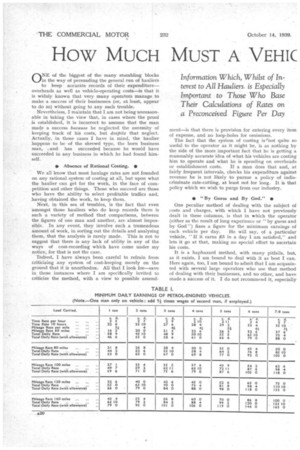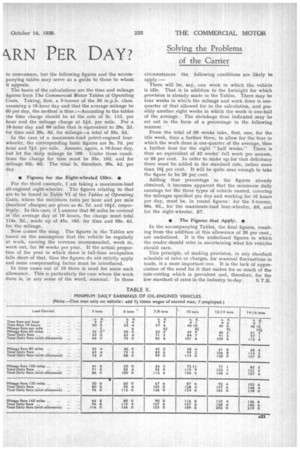How MUCH MUST A VEHIC ikRN PER DAY?
Page 22

Page 23

If you've noticed an error in this article please click here to report it so we can fix it.
Solving the Problems of the Carrier
information Which, Whilst of interest to All Hauliers. is Especially important to Those Who Base Their Calculations of Rates on a Preconceived Figure Per Day ONE of the biggest of the many stumbling blocks in the way of persuading the general run of hauliers to keep accurate records of their expenditure— overheads as well as vehicle-operating costs—is that it is widely known that very many operators manage to make a success of their businesses .(or, at least, appear to do so) without going to any such trouble.
• . Nevertheless, I maintain that I am not being -unreasonable in taking the view that, in cases where the proof is established, it is incorrect to assume that the man made a success because he neglected the necessity of keeping track of his costs, but despite that neglect. Actually, in those cases I have in mind, the haulier happens to be of the shrewd type, the born business man, . and has succeeded because he would have succeeded in any business in which he had found himself.
• Absence of Rational Costing. • We all know that most haulage rates are not founded on any rational system of costing at all, but upon what the haulier can get for the work, in the face of competition and other things. Those who succeed are those who have the ability to select profitable traffics and, having obtained the work, to keep them.
Next, in this sea of troubles, is the fact that even amongst those hauliers who do keep records there is such a variety of method that comparisons, between the figures of one man and another, are almost impossible. In any event, they involve such a tremendous amount of work, in sorting out the details and analysing them, that the analysis is rarely made. This is not to suggest that there is any lack of utility in any of the ways of cost-recording which have come under my notice, for that is not the case.
Indeed, I have always been careful to refrain from criticizing any system of cost-keeping merely on the ground that it is unorthodox, All that I look for—save in those instances where I am specifically invited to criticize the method, with a view to possible amend
ment—is that there is provision for entering every item of expense, and no loop-holes for omissions.
The fact that the system of costing is not quite so useful to the operator as it might be, is as nothing by the side of the more important fact that he is getting a reasonably accurate idea of what his vehicles are costing him to operate and what he is spending on overheads
or establishment costs. If a man does that and, at fairly frequent intervals, checks his expenditure against revenue he is not likely to pursue a policy of indiscriminate rate-cutting, at least not for long. It is that policy which we wish to purge from our industry.
• "By Guess and By God." • One peculiar method of dealing with the subject of costs and charges, with which 1 have not previously dealt in these columns, is that in which the operator (either as the result of Tong experience or "by guess and by God ") fixes a figure for the minimum earnings of
each vehicle per day. He will say, of a particular vehicle, " If it earns E.3 in a day I am satisfied," and lets it go at that, making no special effort to ascertain his costs.
It is a haphazard method, with many pitfalls, but, as it exists, I am bound to deal with it as best I can. Here again, too, I am bound to admit that I am acquainted with several large operators who use that method of dealing with their businesses, and no other, and have made a success of it. I do not recommend it, especially
to newcomers, but the following figures and the accompanying tables may serve as a guide to those to whom it appeals.
The bases of the calculations are the time and mileage figures from The Commercial Motor Tables of Operating Costs. Taking, first, a 5-tonner of the 30 m.p.h. class, assuming a 10-hour day and that the average mileage be 60 per day, the method is thus :—According to the tables the time charge should be at the rate of 2s. I Id. per hour and the mileage charge at 5fd. per mile. For a 10-hour day and 60 miles that is equivalent to 29s. 2d. for time and 26s, 3d. for mileage—a total of 55s. 5d.
In the case of a maximum-load petrol-engined fourwheeler, the corresponding basic figures are 3s. 7d. per hour and 74c1. per mile. Assume, again, a 10-hour day, but let the daily mileage be 100. Under those conditions the charge for time must be 35s. I0d. and for mileage 62s. 6d. The total is, therefore, 98s. 4d. per day.
• Figures for the Eight-wheeled Oiler. •
For the third example, I am taking a maximum-load oil-engined eight-wheeler. The figures relating to that are to be found in Table V1 of the Tables of Operating Costs, where the minimum rates per hour and per mile (hauliers' charges) are given as 4s. 7d. and 10d, respectiviply. In this case, if I assume that 80 miles be covered in the average day of 10 hours, the charge must total 114s. 2d., made up of 45s. lOd. for time and 68s. 4d. for the mileage.
Now comes the snag. The figures in the Tables are based on the assumption that the vehicle be regularly at work, earning the revenue recommended, week in, week out, for 50 weeks per year. If the actual proportion of the year in which there is full-time occupation falls short of that, then the figures do not strictly apply and some compensating factor must be introduced.
In nine cases out of 10 there is need for some such allowance. This is particularly the case where the work done is, in any sense of the word, seasonal. In those circumstances the following conditions are likely to apply :—
There will be, say, one week in which the vehicle is idle. That is in addition to the fortnight for which provision is already made in the Tables. There may be four weeks in which the mileage and work done is onequarter of that allowed for in the calculation, and possibly another eight weeks in which the work is one-half of the average. The shrinkage thus indicated may be set out in the form of a percentage in the following manner. • From the total of 50 weeks take, first, one, for the idle week, then a further three, to allow for the four in which the work done is one-quarter of the average, then a further four for the eight "half weeks." There is thus an equivalent of 42 weeks' full work per annum, or 84 per cent. In order to make up for that deficiency there must be added to the standard rate, rather more than 19i per cent. It will be quite near enough to take the figure to be 20 per cent.
Adding that percentage to the figures already obtained, it becomes apparent that the minimum daily earnings for the three types of vehicle named, covering the mileages specified per day and working for 10 hours per day, must be, in round figures: for the 5-tonner, 66s. 6d., for the maximum-load four-wheeler, £6, and for the eight-wheeler, £7.
• The Figures that Apply. • In the accompanying Tables, the final figures, resulting from the addition of this allowance of 20 per cent., are underlined. It is the underlined figures to which the reader should refer in ascertaining what his vehicles should earn.
This principle, of making provision, in any standard schedule of rates or charges, for seasonal fluctuations in trade, is a most important one. It is the lack of appreciation of the need for it that makes for so much of the rate-cutting which is prevalent and, therefore, for the low standard of rates in the industry to-day. S.T.R.




















































